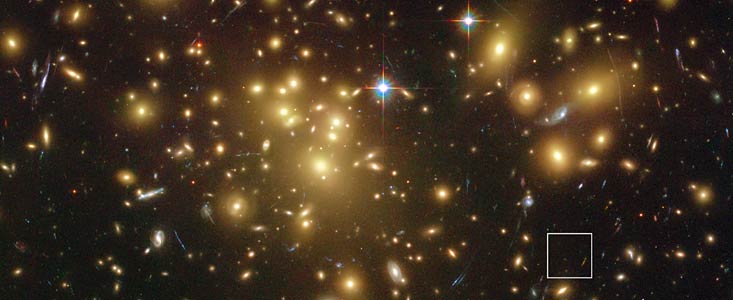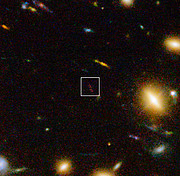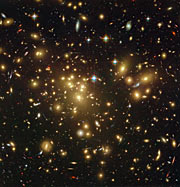Press Release
An Old-looking Galaxy in a Young Universe
ALMA and VLT probe surprisingly dusty and evolved galaxy
2 March 2015
One of the most distant galaxies ever observed has provided astronomers with the first detection of dust in such a remote star-forming system and tantalising evidence for the rapid evolution of galaxies after the Big Bang. The new observations have used ALMA to pick up the faint glow from cold dust in the galaxy A1689-zD1 and used ESO’s Very Large Telescope to measure its distance.
A team of astronomers, led by Darach Watson from the University of Copenhagen, used the Very Large Telescope’s X-shooter instrument along with the Atacama Large Millimeter/submillimeter Array (ALMA) to observe one of the youngest and most remote galaxies ever found. They were surprised to discover a far more evolved system than expected. It had a fraction of dust similar to a very mature galaxy, such as the Milky Way. Such dust is vital to life, because it helps form planets, complex molecules and normal stars.
The target of their observations is called A1689-zD1 [1]. It is observable only by virtue of its brightness being amplified more than nine times by a gravitational lens in the form of the spectacular galaxy cluster, Abell 1689, which lies between the young galaxy and the Earth. Without the gravitational boost, the glow from this very faint galaxy would have been too weak to detect.
We are seeing A1689-zD1 when the Universe was only about 700 million years old — five percent of its present age [2]. It is a relatively modest system — much less massive and luminous than many other objects that have been studied before at this stage in the early Universe and hence a more typical example of a galaxy at that time.
A1689-zD1 is being observed as it was during the period of reionisation, when the earliest stars brought with them a cosmic dawn, illuminating for the first time an immense and transparent Universe and ending the extended stagnation of the Dark Ages. Expected to look like a newly formed system, the galaxy surprised the observers with its rich chemical complexity and abundance of interstellar dust.
“After confirming the galaxy’s distance using the VLT,” said Darach Watson, “we realised it had previously been observed with ALMA. We didn’t expect to find much, but I can tell you we were all quite excited when we realised that not only had ALMA observed it, but that there was a clear detection. One of the main goals of the ALMA Observatory was to find galaxies in the early Universe from their cold gas and dust emissions — and here we had it!”
This galaxy was a cosmic infant — but it proved to be precocious. At this age it would be expected to display a lack of heavier chemical elements — anything heavier than hydrogen and helium, defined in astronomy as metals. These are produced in the bellies of stars and scattered far and wide once the stars explode or otherwise perish. This process needs to be repeated for many stellar generations to produce a significant abundance of the heavier elements such as carbon, oxygen and nitrogen.
Surprisingly, the galaxy A1689-zD1 seemed to be emitting a lot of radiation in the far infrared [3], indicating that it had already produced many of its stars and significant quantities of metals, and revealed that it not only contained dust, but had a dust-to-gas ratio that was similar to that of much more mature galaxies.
“Although the exact origin of galactic dust remains obscure,” explains Darach Watson, “our findings indicate that its production occurs very rapidly, within only 500 million years of the beginning of star formation in the Universe — a very short cosmological time frame, given that most stars live for billions of years.”
The findings suggest A1689-zD1 to have been consistently forming stars at a moderate rate since 560 million years after the Big Bang, or else to have passed through its period of extreme starburst very rapidly before entering a declining state of star formation.
Prior to this result, there had been concerns among astronomers that such distant galaxies would not be detectable in this way, but A1689-zD1 was detected using only brief observations with ALMA.
Kirsten Knudsen (Chalmers University of Technology, Sweden), co-author of the paper, added, “This amazingly dusty galaxy seems to have been in a rush to make its first generations of stars. In the future, ALMA will be able to help us to find more galaxies like this, and learn just what makes them so keen to grow up.”
Notes
[1] This galaxy was noticed earlier in the Hubble images, and suspected to be very distant, but the distance could not be confirmed at that time.
[2] This corresponds to a redshift of 7.5.
[3] This radiation is stretched by the expansion of the Universe into the millimetre wavelength range by the time it gets to Earth and hence can be detected with ALMA.
More information
This research was presented in a paper entitled “A dusty, normal galaxy in the epoch of reionization” by D. Watson et al., to appear online in the journal Nature on 2 March 2015.
The team is composed of D. Watson (Niels Bohr Institute, University of Copenhagen, Denmark), L. Christensen (University of Copenhagen), K. K. Knudsen (Chalmers University of Technology, Sweden), J. Richard (CRAL, Observatoire de Lyon, Saint Genis Laval, France), A. Gallazzi (INAF-Osservatorio Astrofisico di Arcetri, Firenze, Italy) and M. J. Michalowski (SUPA, Institute for Astronomy, University of Edinburgh, Royal Observatory, Edinburgh, UK).
ESO is the foremost intergovernmental astronomy organisation in Europe and the world’s most productive ground-based astronomical observatory by far. It is supported by 16 countries: Austria, Belgium, Brazil, Czechia, Denmark, France, Finland, Germany, Italy, the Netherlands, Poland, Portugal, Spain, Sweden, Switzerland and the United Kingdom, along with the host state of Chile. ESO carries out an ambitious programme focused on the design, construction and operation of powerful ground-based observing facilities enabling astronomers to make important scientific discoveries. ESO also plays a leading role in promoting and organising cooperation in astronomical research. ESO operates three unique world-class observing sites in Chile: La Silla, Paranal and Chajnantor. At Paranal, ESO operates the Very Large Telescope, the world’s most advanced visible-light astronomical observatory and two survey telescopes. VISTA works in the infrared and is the world’s largest survey telescope and the VLT Survey Telescope is the largest telescope designed to exclusively survey the skies in visible light. ESO is a major partner in ALMA, the largest astronomical project in existence. And on Cerro Armazones, close to Paranal, ESO is building the 39-metre European Extremely Large Telescope, the E-ELT, which will become “the world’s biggest eye on the sky”.
Links
Contacts
Darach Watson
Niels Bohr Institute
University of Copenhagen, Denmark
Tel: +45 2480 3825
Email: darach@dark-cosmology.dk
Kirsten K. Knudsen
Chalmers University of Technology
Onsala, Sweden
Tel: +46 31 772 5526
Cell: +46 709 750 956
Email: kirsten.knudsen@chalmers.se
Richard Hook
ESO education and Public Outreach Department
Garching bei München, Germany
Tel: +49 89 3200 6655
Cell: +49 151 1537 3591
Email: rhook@eso.org
About the Release
| Release No.: | eso1508 |
| Name: | Abell 1689 |
| Type: | Early Universe : Galaxy : Grouping : Cluster |
| Facility: | Atacama Large Millimeter/submillimeter Array, Very Large Telescope |
| Instruments: | X-shooter |
| Science data: | 2015Natur.519..327W |
Our use of Cookies
We use cookies that are essential for accessing our websites and using our services. We also use cookies to analyse, measure and improve our websites’ performance, to enable content sharing via social media and to display media content hosted on third-party platforms.
ESO Cookies Policy
The European Organisation for Astronomical Research in the Southern Hemisphere (ESO) is the pre-eminent intergovernmental science and technology organisation in astronomy. It carries out an ambitious programme focused on the design, construction and operation of powerful ground-based observing facilities for astronomy.
This Cookies Policy is intended to provide clarity by outlining the cookies used on the ESO public websites, their functions, the options you have for controlling them, and the ways you can contact us for additional details.
What are cookies?
Cookies are small pieces of data stored on your device by websites you visit. They serve various purposes, such as remembering login credentials and preferences and enhance your browsing experience.
Categories of cookies we use
Essential cookies (always active): These cookies are strictly necessary for the proper functioning of our website. Without these cookies, the website cannot operate correctly, and certain services, such as logging in or accessing secure areas, may not be available; because they are essential for the website’s operation, they cannot be disabled.
Functional Cookies: These cookies enhance your browsing experience by enabling additional features and personalization, such as remembering your preferences and settings. While not strictly necessary for the website to function, they improve usability and convenience; these cookies are only placed if you provide your consent.
Analytics cookies: These cookies collect information about how visitors interact with our website, such as which pages are visited most often and how users navigate the site. This data helps us improve website performance, optimize content, and enhance the user experience; these cookies are only placed if you provide your consent. We use the following analytics cookies.
Matomo Cookies:
This website uses Matomo (formerly Piwik), an open source software which enables the statistical analysis of website visits. Matomo uses cookies (text files) which are saved on your computer and which allow us to analyze how you use our website. The website user information generated by the cookies will only be saved on the servers of our IT Department. We use this information to analyze www.eso.org visits and to prepare reports on website activities. These data will not be disclosed to third parties.
On behalf of ESO, Matomo will use this information for the purpose of evaluating your use of the website, compiling reports on website activity and providing other services relating to website activity and internet usage.
Matomo cookies settings:
Additional Third-party cookies on ESO websites: some of our pages display content from external providers, e.g. YouTube.
Such third-party services are outside of ESO control and may, at any time, change their terms of service, use of cookies, etc.
YouTube: Some videos on the ESO website are embedded from ESO’s official YouTube channel. We have enabled YouTube’s privacy-enhanced mode, meaning that no cookies are set unless the user actively clicks on the video to play it. Additionally, in this mode, YouTube does not store any personally identifiable cookie data for embedded video playbacks. For more details, please refer to YouTube’s embedding videos information page.
Cookies can also be classified based on the following elements.
Regarding the domain, there are:
- First-party cookies, set by the website you are currently visiting. They are stored by the same domain that you are browsing and are used to enhance your experience on that site;
- Third-party cookies, set by a domain other than the one you are currently visiting.
As for their duration, cookies can be:
- Browser-session cookies, which are deleted when the user closes the browser;
- Stored cookies, which stay on the user's device for a predetermined period of time.
How to manage cookies
Cookie settings: You can modify your cookie choices for the ESO webpages at any time by clicking on the link Cookie settings at the bottom of any page.
In your browser: If you wish to delete cookies or instruct your browser to delete or block cookies by default, please visit the help pages of your browser:
Please be aware that if you delete or decline cookies, certain functionalities of our website may be not be available and your browsing experience may be affected.
You can set most browsers to prevent any cookies being placed on your device, but you may then have to manually adjust some preferences every time you visit a site/page. And some services and functionalities may not work properly at all (e.g. profile logging-in, shop check out).
Updates to the ESO Cookies Policy
The ESO Cookies Policy may be subject to future updates, which will be made available on this page.
Additional information
For any queries related to cookies, please contact: pdprATesoDOTorg.
As ESO public webpages are managed by our Department of Communication, your questions will be dealt with the support of the said Department.





